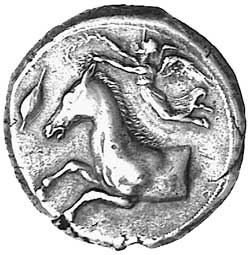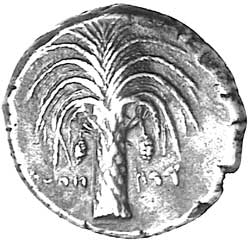Greek Silver & Bronze


Lot 2426 Greek Silver & Bronze
Estimate $3,000
Bid at live.noble.com.au
SOLD $2,500
SICULO-PUNIC, 'Carthage' (c.410-395 B.C.), silver tetradrachm, (17.436 grams), obv. forepart of a bridled horse to left, crowned by Nike above flying to left, grain ear before horse, line border, rev. palm tree with drooping branches and two date clusters, legend across field 'QRT/HDST'. (cf.S.6426, Jenkins SNR 53, 30 [same dies O8/R29], SNG Lloyd 1607 [same dies]). Good very fine with a delightful tone and black patination on the highlights, only three recorded by Jenkins and extremely rare.
Ex Itallo Vecchi Sale No.16 (lot 84). 'QART HADAST', Punic for 'New City' (Carthage). This coinage is among the first produced by the Carthaginians and is one of the very limited number with the name of the city on the coin. The series represents only a small part of the tetradrachms produced by Carthage. It was struck from a very limited number of dies, in all only twelve obverse dies. Among these, only four have the QRDTHDST Punic legend (without reference to mints 'in the Camp') and as such are very likely to have been produced in Carthage itself and shipped to Sicily for mercenary payment. Following the defeat of Hamilcar (Magonid) by Gelon at the battle of Himera in 480 B.C., the Carthaginians remained aloof from Sicilian affairs for the next 70 years. They intervened in 410 B.C. on behalf of Segesta against Selinus (for which this coinage was struck) to pay the mercenaries and troops in that campaign. Diodorus Siculus tells us (XIII, 44) 'After the return of their ambassadors, the Carthaginians dispatched to the Segesteans five thousand Libyans and eight hundred Campanians. ...the Carthaginians purchased horses for them all, gave them high pay, and sent them to Segesta.' Following the destruction of Selinus, Hannibal (the Magonid [not Barca]) turned his forces against Himera and ultimately destroyed the city, revenging the death of his grandfather Hamilcar. This campaign eventuated in Carthaginian control of most of Western Sicily and the first treaty between the Carthaginians and Dionysius, tyrant of Syracuse, in 395 B.C. This coin and the others in this collection are some of only a few that survived from that war. Consequently it provides the collector a very rare opportunity of aquisition of such historical and beautiful coins.
Estimate / sale price does not include buyer's premium (currently 22% including GST) which is added to hammer price. All bids are executed on the understanding that the Terms & Conditions of sale have been read and accepted. For information on grading and estimates please refer to the Buying at Auction advice.
Quick find
View a lot by number and sale.
Adjacent lots
Lot 2424
SICULO-PUNIC, (c.410-395 B.C.), silver tetradrachm, (16.962 grams), obv. forepart of a horse to right, grain ...
Estimate $2,400
Lot 2425
SICULO-PUNIC, (c.410-395 B.C.), silver tetradrachm, (17.546 grams), obv. forepart of a horse to left, crowned ...
Estimate $3,000
Lot 2426 This lot
SICULO-PUNIC, 'Carthage' (c.410-395 B.C.), silver tetradrachm, (17.436 grams), obv. forepart of a bridled horse to ...
Estimate $3,000
Lot 2427
SICULO-PUNIC, (c.410-395 B.C.), silver tetradrachm, (17.200 grams), obv. forepart of a horse to left, crowned ...
Estimate $3,000
Lot 2428
SICULO-PUNIC, (c.350-320/315 B.C.), silver tetradrachm, uncertain mint, (16.842 grams), obv. head of Persephone or Kore ...
Estimate $1,200